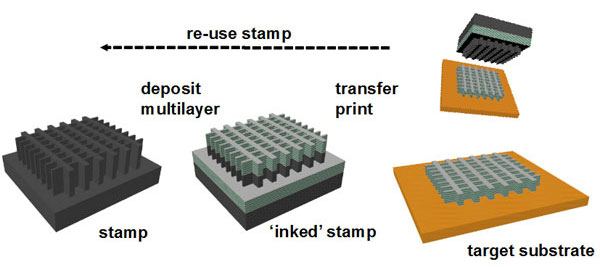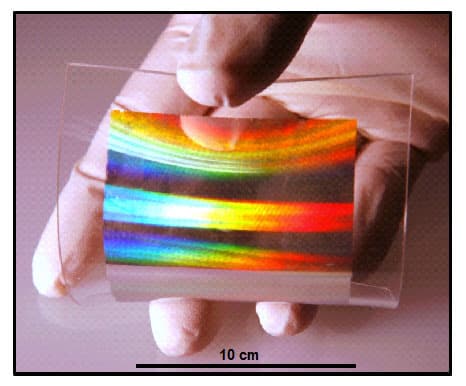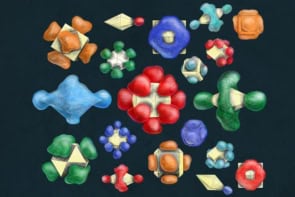
Researchers at the University of Illinois at Urbana-Champaign have figured out a way to fabricate 3D “negative index” metamaterials (NIMs) by the square foot. The feat is a real advance over traditional fabrication techniques that are slow and which can only make such materials over small areas.
Metamaterials are man-made structures that have very different properties to those of naturally occurring materials. For example, NIMs are structures artificially engineered to have a negative index of refraction. This means that light travelling through such materials is bent in the “wrong way” compared with that in normal materials, which have a positive index.
NIMs have a number of desirable properties that do not exist in normal materials, including the ability to focus light to a point smaller than its wavelength. Scientists have already used these structures to make novel devices such as “invisibility cloaks” and hyperlenses – devices that can image objects much smaller than is possible using an optical microscope.
Until now, however, techniques to produce NIMs were limited to micron-sized surface areas. John Rogers and colleagues’ new method, which is based on nanotransfer printing, overcomes this problem. “The advance is important because such an approach will be required for any practical applications of these materials,” said Rogers.
The researchers begin by making a high-resolution stamp comprising “hills” and “valleys” on the surface of a moulded polymer. By then depositing alternate layers of materials using an evaporation process, they are able to coat the entire surface (both the raised and depressed regions) with precise multilayer stacks. By peeling off the stacks from just the raised regions allows them to produce a thin film structure that looks like a fishnet, which can be transferred to other substrates such as glass or plastic.
The stamp can be used again for another fabrication cycle and the multilayer fishnets can be designed to have a negative index of refraction. Rogers and co-workers showed that this was possible by detailed optical measurements and modelling studies on the structure.
New applications
“Conventional methods use a focused beam of electrons or ions to fabricate the fishnets in a serial, slow process that are typically applied over areas of a fraction of a square millimetre,” Rogers said. “Our structures are formed in parallel and we can make fishnet structures at the scale of 10 × 10 cm, limited only by the tooling in our academic cleanroom facilities.”
Scientists are very much interested in artificial metamaterial structures that have a negative index of refraction. Applications range from ultrathin, high-performance lenses, to photonic device components, sensors and the famous invisibility cloaks.
The team is now busy working on scaling down the feature sizes of its structures so that they operate in the visible wavelength range. Operation in the visible has been difficult to achieve so far because the structures in the metamaterials must be about the same size as the wavelength of the radiation – for light, this is hundreds of nanometres. “We are also exploring applications of large-area sheets of flexible NIMs,” revealed Rogers.
The work was published in Nature Nanotechnology.




